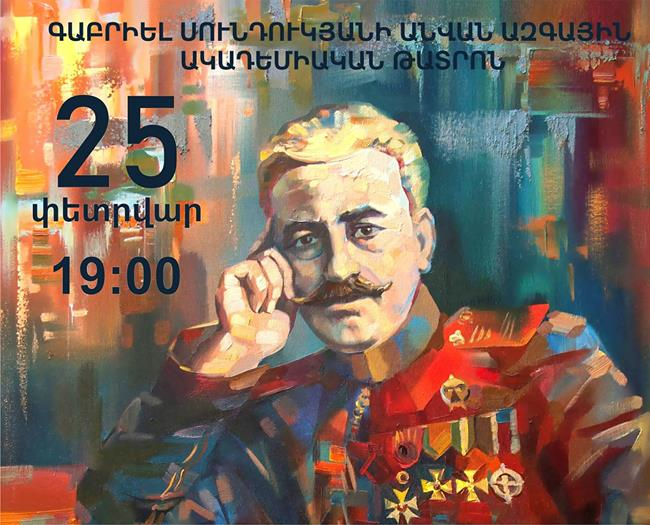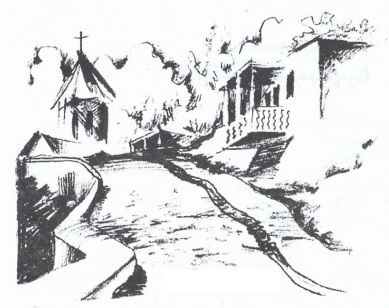Hayrik Muradyan is a unique phenomenon within Armenian popular folklore. By profession Muradyan was a historian, who rendered invaluable service for saving various popular songs from extinction. During his long life dedicated to different areas he constantly replenished traditional songlists that he had mastered and sang in his childhood (he performed more than 150 songs by heart).
Hayrik Muradyan was to some degree a researcher as well. He looked for songs among his compatriots and compared them. Alongside with traditional songs spread in his native city of Shatakh he also presented the song versions of neighbouring provinces as well. This distinction makes the melodic, rhythmic or modulation differences appear quite evidently and gives musicologists the opportunity to study those melodic dialects. Besides, Muradyan provided specific information on each song, choreographic, as well as other interesting materials about the best folk singers and composers.
It is also worth mentioning that Hayrik Muradyan vividly describes the daily life, lifestyle and particularly music in the background of general historical events going on in his native province in the early 20th century. His profession much contributed to this work.
Hayrik Muradyan was not a mere choreographer, but also a performer of a delicate taste. The nature generously endowed him with a keen ear, great musicality, soft, beautiful and supple voice and a surprisingly good memory. From the 1960s onward Muradyan’s voice appeared everywhere; on stages, on a radio and television, in halls of various organizations and educational institutions, where he was invited to have hearty talks about the undeservedly neglected traditional Armenian folklore. The participants were delighted by his charming voice, calm, ordinary and purely national performing style. Naturally, there was a growing desire among youth to learn folk songs and dances, their invaluable and ancestral inheritance that had come to them from generations. So, this marked the birth of Yerevan State University National Ensemble, which prepared ground for the creation of YSU Cultural Club. Afterwards “Van” and “Tsiler” Ensembles were created in Politechnical University (currently Engineering University) consisting of students and children respectively. It was with great love and excitement that Hayrik Muradyan supported and taught them to perform songs and dances of Vaspurakan. He was loved and respect by people. His participation and performances gave special breath and air to Annual May Folkloric Festival that was initiated by Politechnical University and soon became a tradition. He was a respectful member of the Festival jury.
Due to Muradyan’s influence a group made up of workers from Language Institute of National Academy was formed under the leadership of Hayrik Muradyan’s daughter, Maro Muradyan. Later this group came to be called “Akunq” National Ensemble and continued its activity under the patronage of Armenian radio and television. Little by little “Akunq” started to engage in a wide stage activity and was warmly welcomed by folk song fans. Songs performed by Hayrik Muradyan served as the core for group’s playslist. During concert tours to different marzes of Armenia “Akunq” members started to collect choreographic materials and thus considerably replenished their songlists with newly-heard and valuable songs.
So, folk song was perfected, took a final shape and acquired a specific charm thanks to the talent and taste of the best folk song performers. It captivated many hearts and came to be owned by people. Thus, neglected folk songs were perfected and renowned by people. This has always been a common practice. The popular folklore survived and came to us from deep centuries due to such talented performers, as Hayrik Muradyan.
The fascinating folk songs performed by Hayrik Muradyan gave specific emotional colouring to the documentary films “A country song” (1972), “Petros Dutryan” (1973), “Vaspurakan Dances” (1973) screened by Hayfilm. William Saroyan’s “Yard of grapes” staged in Yerevan Theatre after Sundukyan was accompanied by Muradyans recordings. His recordings were released by Melodia company in Moscow. Two of the songs performed by Muradyan were included in the first of four recordings released in Paris in 1971 and became the first chapter representing Armenian popular folklore in the collection series of “World Folklore.” Composed works could not remain unaffected and stay indifferent to Armenian folk song as a result of similar developments.
So from 1960’s onward there was an unprecedented incline in folk, led by Hayrik Muradyan. Wherever he performed, his voice admired and excited the audience, captivated people by pureness of national performing style and noble taste. His truthfulness to the native style comes from childhood years, when his musical inner world was shaped under the influence of what he had learned in the native village.
Hayrik Muradyan was born on May 3, in 1905 in the village of Jnuk (Shatakh province of Van Vilayet). He had interesting memories about his own birth. Hasmik Harutyunyan, one of his best disciples and one of the best folk song performers, who visited Muradyan quite often during his last days, talked and performed with him, learned new songs from her teacher, also recorded the following story:
“My mother went to the slopes of Mount Arnos to pick greens. The day was clear and warm. Suddenly the weather changed and Mount Arnos grew sombre. It began to rain and hail. My expectant mother had to keep rhubarb’s giant leaf over her head, climb up and find a shelter in a nearby cave. Suddenly she was in labour and soon she could hear my cries. My mother didn’t panic and swiftly put off her blouse and wrapped me up. Then she cut off my navel by blade used for reaping.”
The cave was not far from our house. Father saw that the weather had changed and worriedly hasted to the slope of Mount Arnos to help mother. As he reached the entrance to the cave, he gazed at me and my mother in an excitement. Then he took us home. Later when I grew up and found out this story, I dedicated these lines to my mother:
Rhubarb’s leaf became a cradle for me,
Merciful mountain served me a nurse
Thunder and lightening hailed me from above
And I felt the kiss of tempest on my lips.
Hence I liked the bolts and violence of winds
And each time thunder roars
Each time lightning strikes
I recall you in my memories.
Each family member had his own attitude to my birth. When I was put in a cradle, my grandmother brought a sewed belt, put it under my pillow and said; “Let he become a carrier and have a sturdy back.” At that time people carried everything on their backs in our village, because, like other villagers, we didn’t have carriages either. My father brought to me Narek (another name for Grigor Narekatsi’s “Book of Lamentation”), put under my pillow and mumbled: “Let he grow a literate son.” While my grandfather unsheathed his sword and said: “Let he become a fedayi.”
“My native Jnuk was very beautiful and cozy village surrounded by mountains, rich with waters and springs and dense forests. There was a church in our village called St Yerekkhoran (lit. having three altars). I can distantly recall the way leading to our house…”
Recalling his childhood years Muradyan wrote: “From an early age I’ve heard and loved songs of our ancestors. My mother Zozan and aunt Sinam were great singers, endowed with innate and perfect voice. Both came from literate families and were known for their patriotically brought up and valiant sons. Two villagers, Shahen Bazikyan and my relative Harutyun Glanyan made an unforgettable impression on me with their song. Their voices gave magic impression of a cello and had a beautiful sonorousness that is hard to describe. Shahen performed ancient folk and epic songs, while Harutyun (Haro) sang patriotic songs. I owe my songs to this specific environment.”
The mountainous Shatakh had a beautiful tradition. In summer and autumn people lit a bonfire in the evenings, gathered around it and had hearty talks about their concerns, local events, told tales and epics, sang and joked. Villagers not only demonstrated and improved their innate performing abilities during such gatherings, but also treated and developed their native songs and language, transmitted them from mouth to mouth, from one generation to another and preserved them. This gatherings also served a specific school for the village children, as they gathered around their parents, enjoyed the conversations, learned to distinguish between the good and the bad, love the truth, straight and just work. During his childhood years Hayrik Muradyan also gained wisdom from this experience.
Unfortunately, the bonfire was soon extinguished. In 1915 he felt the bitterness of the exile, deprivation of his land, hunger and sufferings, became the bystander of massacres in Berkra gorge, Kosal and Sarinkalal. As a consequence of deportation of Armenian population from Shatakh, the 54 members of the Muradyan ancestral family took the route of exile. “From Shatakh to Salmast province of Iran, back to Van, then again to Iran and the Iraqi deserts; these were the places we roamed during three years.”
After long and torturous wanderings the Muradyan family of which only 4 members were left then (mother, brother, uncle and him) finally repatriated from Iran to Armenia in 1921 among the first lines and resettled in Verin Artashat village. Firstly young Muradyan was engaged in farm labouring and soon after was elected the president of the newly-established Union of Farm Labourers that became the first similar union in Armenia. Without interrupting his work, he finished a secondary school and graduated from the Department of History of Yerevan State University.
His peaceful work was interrupted by the breakout of the Great Patriotic War. He was called in to the front to serve in military service.
Hayrik Muradyan was awarded by a number of governmental awards, including Medal of Honour for his loyal services rendered elsewhere, both during wartime and peace.
Though his sufferings, he never forgot his native village and the traditional songs that he learned in his childhood. Song was an inseparable guide for Muradyan to everywhere; in the city or village, during peaceful life or in the trenches of Second World War. It became a remedy for hard days and shared his sorrow and delight.
Hayrik Muradyan not only invited public’s attention to a whole cultural layer that was on the verge of extinction, but also proved that Armenian folk song in its natural form has the equal right to persist alongside with professional polyphonic music. This task could only be initiated by a real patriot, music lover and connoisseur.
Source: Alina Pahlevanyan, “Native Songs”



